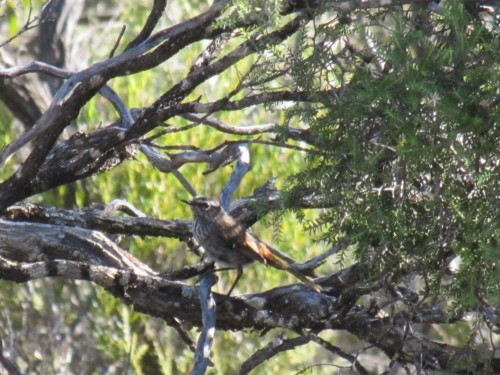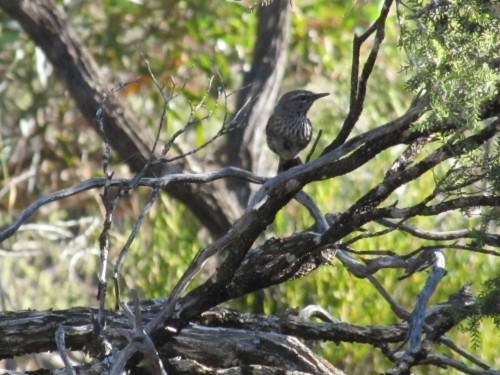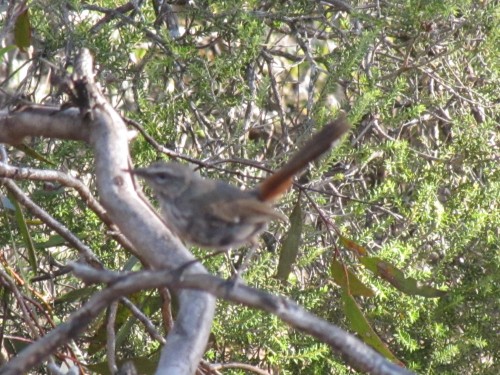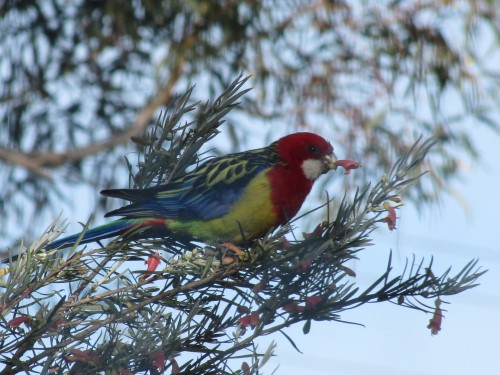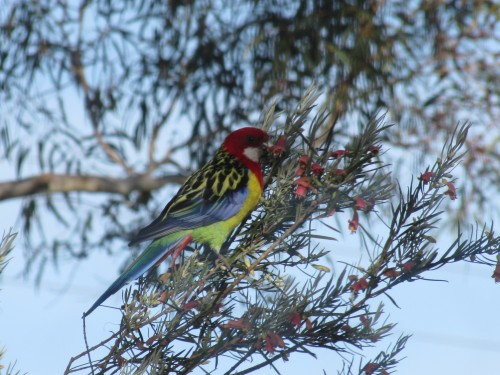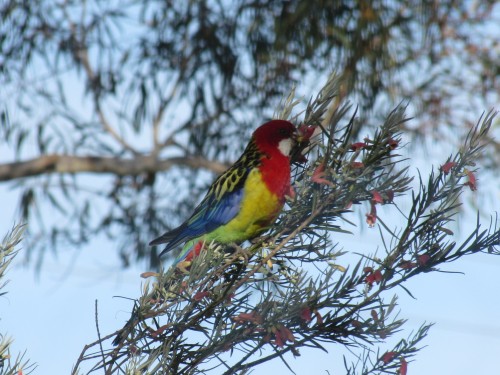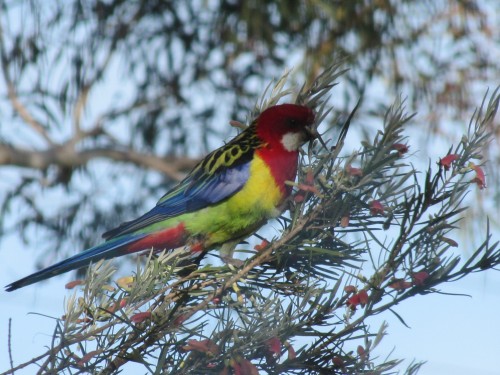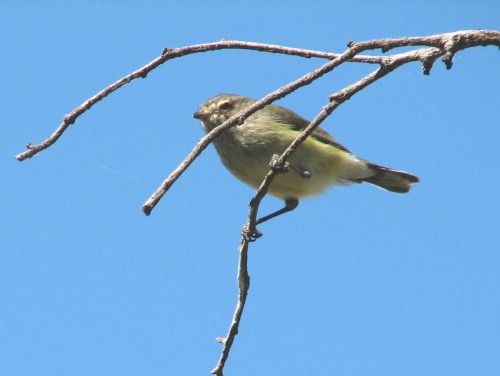A Shy Heathwren comes out of hiding
One of the more interesting birding spots near my home in Murray Bridge South Australia is Lowan Conservation Park near Bowhill, about a 40 minute drive to the north east. This park is mainly mallee eucalypt scrub with some native pine (Callitris) and smaller shrubby undergrowth, including acacias, eremophilas, spinifex and some annual flowering plants.
The birdlife in this park can vary from overwhelming in number to very few. It all depends upon what is flowering at the time. When many of the mallee trees are in flower the honeyeaters flock there in large numbers. When nothing is flowering I’ve struggled to list more than a dozen species – and sometimes no honeyeaters, with the possible exception of a solitary Red Wattlebird. It can be very rewarding – or downright frustrating.
On a visit early last year I was delighted to catch a glimpse of a Shy Heathwren, not a species which is common in this region. True to its name it proved to be elusive but very vocal. A birding friend had a bird field guide application on his phone, so he played the call of this species. Within seconds it was almost hopping around our feet. I was therefore able to get a few not-so-brilliant shots. Wish it had sat still for more than a half second!
As a result of this experience I just had to go and buy myself a smart phone – along with a bird guide app.
UPDATE: I have since bought a smart phone AND have a field guide app on it. I haven’t used it much for calls out bush, but my grandchildren think it is really cool. [sigh]
A more recent article about this park can be found here.
Updated July 2015.
Mallee Ringneck parrots feeding young
We have a family of 6 to 8 Mallee Ringneck parrots resident in our garden. We see them every day and they love feeding on the flowers of plants like the Eremophila shown in the photo above. They are also partial to our pears – before they are fully ripe. (Last summer we managed to foil them by draping bird netting over the trees. Yes!)
Quite often we have seen several of the parrots sitting at the entrance of a large hollow in one of our trees. We also see them entering and leaving this hollow. We’ve suspected that they have been nesting in this hollow, but we lacked definite proof until earlier this week.
My wife, who runs a small nursery growing Australian native plants (click to visit), was working in the nursery when she noticed a ringneck feeding a young one in the tree near her. So we can only assume that they have recently used the hollow (or another one nearby) to raise a family.
The Mallee Ringneck is a race of the Australian Ringneck.
Now the Eastern Rosella is back home
For almost two years now we have had an Eastern Rosella occasionally visit our garden and patch of mallee scrub. During some weeks we see it several times a day, every day. On other occasions it may only visit once and then not again for a week or two. It is an unusual visitor for a number of reasons.
- Eastern Rosellas are not normally found in the Murray Bridge region. They are common in the eastern states and even in the south east of South Australia. They have been introduced to the Adelaide region. All I can assume is that this species is extending its range or this one bird has escaped from someone’s aviary – or has been released.
- The other unusual matter relates to its behaviour: it is regularly seen in the company of a Mallee Ringneck. We have up to a dozen ringnecks around at any one time, but most of them do not tolerate this “interloper” and will vigorously chase it off. It keeps returning; such persistence.
For the last month we hadn’t seen the rosella, but earlier this week it reappeared, again in the company of a ringneck and again being harassed by the other ringnecks. On Wednesday it posed nicely for my camera while eating the flowers of one of our Eremophila youngii bushes.
Further reading:
- Now we have two Eastern Rosellas
- Adelaide Rosellas in our garden
- Mallee Ringneck Parrot
- Parrots eating our flowers
- Eremophilas – articles about Eremophilas on my wife’s site.
A little bird encounter
I haven’t ventured out much over the last few weeks. It has been a wet winter so far and we’ve have many rain-sodden days. On the days where it hasn’t rained, we’ve either had frequent showers, overcast skies or bitterly cold winds – sometimes all three. The weather has not encouraged anyone to be out in it. Added to my misery of being stuck indoors was the fact that I’ve been very sick over that period. Bronchitis (and several other health issues) has made life even more miserable than it already was.
I’m slowly on the mend, and today we had a lovely winter’s day, typical of many days at this time of the year. After a cold night and a near frosty morning, the sun shone brightly all day. I even managed a half hour of reading while sitting in the sun on our back veranda. It was delightful, and I received a good dose of vitamin D as a bonus. I hope it will help the healing process.
At one stage I wandered up into our small patch of mallee scrub. Mallee trees are eucalypts and are very common in this part of South Australia. As I slowly walked through the trees a small group of Weebills sat calling sweetly in the branches not two metres above my head. They weren’t at all perplexed by my presence.
Lovely.
The Rainbow Beeeaters have arrived
Over the last few weeks the Rainbow Bee-eaters have be flying around our garden and mallee scrub. During the winter months they head north to warmer parts of the country, and every spring they head south for spring and summer.
It is always a delight when we hear them arrive. It’s a sure sign that spring has arrived. Almost every day for the last few weeks we’ve heard them around, or seen them overhead. Perhaps this year they will nest on our property like they did some years ago?
I find their nesting habit to be quite unusual. They make a short 30 – 40cm tunnel in a sandy spot and then construct a small nesting hollow at the end of the tunnel where they lay the eggs. Sometimes the burrow into the side of a road cutting, or the bank of a creek or river, providing the dirt is not too hard or compacted. I remember being fascinated by these birds as a child growing up on a farm in the Murray Mallee region of South Australia. That fascination has remained to this day.
